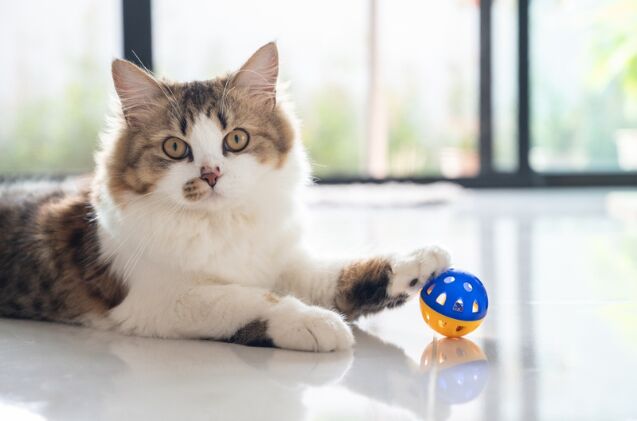How Do I Teach My Cat to Play Fetch?

Unlike dogs, cats aren’t exactly known for their love of fetch. If you dream of tossing a toy with your furry best friend for hours, fear note – with a bit of time, patience, and positive reinforcement, you may just inspire a new love for the game in your kitty.
This post will discuss why some cats take to fetch so naturally and how play can benefit your cat’s overall health and well-being. Plus, we’ll share how to teach your cat to play fetch step-by-step with tips for success!
So, grab your cat’s favorite toy and get ready for a fun game of fetch…
Why Do Cats Love Playing Fetch?
There are many theories about why cats enjoy this game.
The most accepted theory is that the action triggers natural hunting instincts. When an object is thrown, it mimics their prey moving across the room. The cat then chases the toy, stalking and hunting it. Retrieving the toy and bringing it back to you is similar to cats bringing their freshly killed prey to their owners as a gift.
Other experts see the game of fetch as an attempt to spend quality time playing together, bonding like we do with our dogs. However, no research confirms either theory.
What Toy Do Cats Love Most?
Finding the best toy for your fetch-loving cat can be a fun process. Why? There is no “one-size-fits-all” solution. Instead, you’ll have to set aside time to play and test which toys your cat connects with most. Think of it as a fun game of trial and error.
We have two cats at home, one of whom is absolutely in love with playing fetch. Pippen, our Maine Coon mix, will bring toys to us randomly throughout the day. She drops them at our feet and meows loudly while pawing at our pant legs, begging us to throw whatever she has brought us.
Here are a few of her favorite toys to play fetch with:
- SmartyKat Skitter Critters Catnip Cat Toys: These little mice are not only the perfect size and weight for cats to carry around, but the fact they include catnip makes them even more enticing. If the theory about hunting is correct, they are a great example of mock prey.
- Catit Eco Cat Toy: Another prey-like toy, this is arguably the top choice in our house. Pippen loves anything with feathers. If you have a tiny kitten, this is a little harder to carry, but Pippen is relatively small, and she has never had a problem.
- Andiker Cat Crinkle Balls: This is another one I have heard other cat parents raving about. The balls make a fun crinkling sound while the foil-like mylar material reflects the light, making them a fun visual spectacle to hunt down.
- SPOT Colorful Springs: These toys may not seem special, but the spring design causes them to bounce around the room unpredictably. This keeps your cat on their toes as they hunt them down with each throw.
- Cat Tube Spring Toys: These toys are made of lightweight mesh material, making them easy to carry around. If you fold them or push down the ends, then let go, they fly through the air.
The goal is to find something your cat loves, wants to retrieve, and can comfortably carry back to you to continue the game.
Is It Normal for a Cat to Never Play?
While you can expect a range of playfulness from cats, with some cats being very playful and others only playing occasionally when they “feel like it,” it’s not normal for a cat to never play at all. A healthy adult cat should get at least 30 to 60 minutes of playtime daily. This can be in one large play session or, ideally, split into shorter play sessions of 10 to 15 minutes.
If you have a cat who appears lazy or unmotivated, you should prioritize turning this around and encouraging them to play more. Otherwise, they will be at a higher risk of potential health complications, including obesity, diabetes, urinary tract diseases, arthritis and other joint-related issues, and fatty liver disease.
How To Teach a Cat to Play Fetch
Some cats naturally understand and gravitate toward the game of fetch with little to no instruction. But this isn’t the case for all cats. While interested in the toys, many cats may need to be shown what exactly you want them to do. The best approach to do this is through positive reinforcement, a process most often associated with dog training.
It’s a popular misconception that training is only for dogs. However, cats can also be trained to do tricks and even walk on leash. The secret is to find the right reward, let your cat lead the pace, and be patient.
Step One: Gather the Supplies
The first thing you must do is gather everything you will need so that it is close at hand. This includes finding a toy your cat finds interesting (I recommend having several) and a high-value cat treat they love.
This treat will be the reward they will be trying to “earn” during the game, so make sure that it’s something they are willing to work for. Your cat may love a treat like Vital Essentials Freeze-Dried Minnows or a lickable treat like the popular Churu tubes. You can also use something simple made at home, like a small piece of boiled chicken or a bit of tuna.
Step Two: Start Close
To begin, roll or move your toy around directly in front of you. Each time your cat comes to interact with the toy, mark their decision by saying “Yes!” or using a clicker, and then give them your chosen reward. Repeat this process until your cat picks up the toy and instantly looks at you, expecting a treat. This shows they have made a clear connection between the two.
Step Three: Introduce the Idea of Retrieving
At this stage, you want to teach your cat that you not only want them to grab the toy but also bring it to you. If your cat already knows to come to their name, call them when they pick up the toy and reward them if they bring it back with them.
You have two options for cats who don’t yet know their name. You could take the time to teach them their name first. Alternatively, you can use other words or sounds to call them over, like the well-known “psp, psp” sound that many people make when they see a cat. The goal is to convince them to carry the toy your way so you can praise them for making that decision.
Does your cat struggle to bring the toy all the way back to you? Don’t worry, that’s a common problem! If this is the case, try breaking the steps down. Reward your cat if they turn and look at you with the toy in their mouth. Then, reward your cat if they take a couple of steps your way. Don’t move on to the next step until you know they are confident in the current one.
Step Four: Target the Toy
This stage may seem small, but anyone who has played “keep away,” aka fetch with a cat that doesn’t want to let go of the toy, can tell you how important it is.
Hold your hand under the toy when your cat comes to you, and reward them when the toy lands in your hand. At first, you will position your hand strategically to ensure the toy lands directly in it so your cat understands what you are asking for. When it appears they understand that they are to place the toy in your hand, try moving it a little further away so they have to decide to move to your hand.
Throughout this step, don’t hold back on the treats! Rewarding your cat each time they complete what is asked will reinforce that doing so leads to good things. This will encourage them to continue delivering the toy directly to you each time you ask.
Step Five: Add Distance
Now that your cat understands that you are asking them to pick up the toy, bring it to you, and drop it in your hand, you have a solid foundation for a game of fetch. The final piece of the puzzle is to add distance.
Toss the toy a little bit in front of you before repeating the process of holding out your hand and calling your cat over. If they confidently retrieve the toy, throw it a little further with the next throw. Before long, you’ll be able to toss the toy across the room, knowing your cat will bring it back.
What Other Games Do Cats Enjoy?
Have you tried introducing fetch to your cat, and they just aren’t interested? While studies show that 94% of cats like playing fetch, that does leave 6% that don’t – regardless of how hard you try to encourage them. You can still enjoy quality time playing together. However, you may need to consider a different game… Here are a few other games that your cat may enjoy:
Cat Fishing
Okay, maybe this isn’t actually fishing. But there are some great toys known as cat wands. These feature a long handle for you to hold and, suspended from the other end, are fun toys. Using the wand, you can make your cat’s toy dance and fly through the air, tempting them and encouraging them to chase after it.
This is an excellent option for cats who may be reluctant to play fetch due to laziness. Why? You are actively moving the toy, piquing their interest the whole time.
Hide and Seek
Another game that touches on your cat’s natural hunting instincts is hide-and-seek. The concept is simple: You hide somewhere around the house and call your cat, and then they have to hunt for you, stalking their “prey.” When they find you, make a big deal out of it, praising them and giving them affection. Then, hide again.
Some cats even enjoy playing this game with the roles reversed, hiding from their owners while you search for them.
Training Games
As previously mentioned, cats can learn tricks like their canine counterparts. Training is a great way to strengthen your bond with a dog, and the same is true for training sessions with your cat. Try teaching your cat to jump up on a chair on command, shake a paw, spin, jump through a hoop, or any other trick you desire.
Dogs are generally more eager to please than cats, making it easier to train them. This means you must focus on giving your cat a good reason to engage in the training process, aka a high-value treat.
You can introduce other training games as your cat starts to buy into the training process. One that works well for most cats is an obstacle course. Include different elements that will challenge you and your cat, like platforms, hoops, and tunnels. Don’t forget an extra special reward to celebrate when you’re finished!
Final Thoughts: Playing Fetch with Your Cat
Play is a great way to build a lasting bond with your cat while keeping them physically active, supporting their health and well-being. While some cats naturally take to games like fetch, your kitty may need some help learning the game.
When teaching your cat to play fetch, start slow. Reward your cat with a high-value treat to create a positive association with retrieving the toy.
Most importantly, remember that the goal is to have fun, even if it doesn’t go according to plan… As long as you make lasting memories and spend quality time with your cat, it’s a complete success!
Join the PetGuide community. Get the latest pet news and product recommendations by subscribing to our newsletter here.

Britt Kascjak is a proud pet mom, sharing her heart (and her home) with her “pack” which includes her husband John, their 2 dogs – Indiana and Lucifer – and their 2 cats – Pippen and Jinx. She has been active in the animal rescue community for over 15 years, volunteering, fostering and advocating for organizations across Canada and the US. In her free time, she enjoys traveling around the country camping, hiking, and canoeing with her pets.
More by Britt























